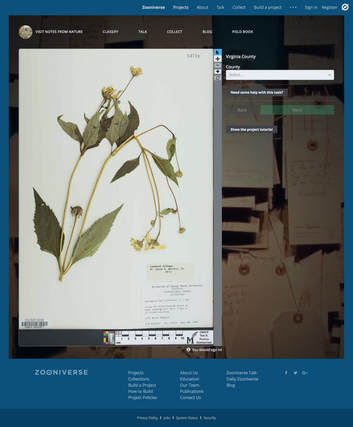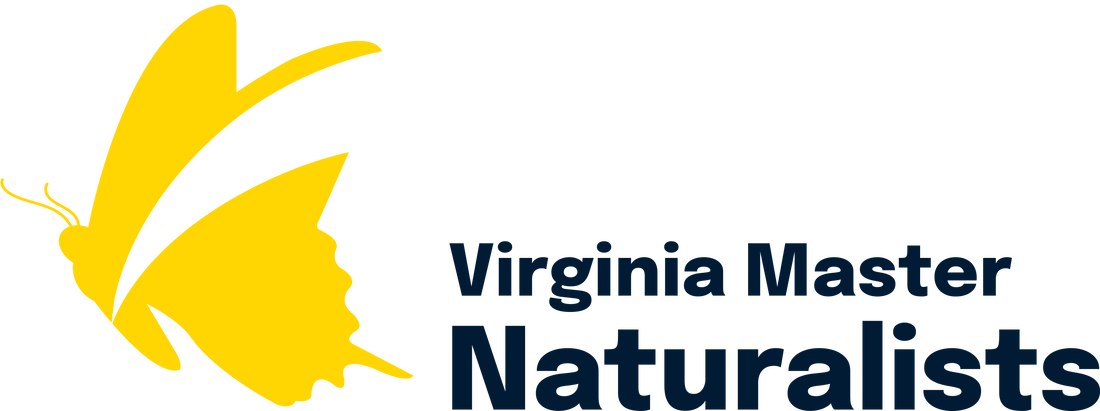 The online herbarium transcription page for VMN volunteers at www.notesfromnature.org.
The online herbarium transcription page for VMN volunteers at www.notesfromnature.org. By Andrea Weeks, Associate Professor and Director of the Ted R. Bradley Herbarium, George Mason University
In Fall 2016, a new online volunteer opportunity for the Virginia Master Naturalists was launched in a webinar entitled, "Digitizing Virginia’s Herbaria for Research and Education". The goal of this volunteer project is to transcribe label information from high-resolution images of Virginian herbarium specimens into an online database. These pressed and dried specimens of native plant species are currently held in cabinets at research institutions around the Commonwealth and they document our flora from the early 1800s to the present day. As the online database grows, it is shared freely with the public and scientists (www.sernecportal.org) to improve our understanding of Virginia’s flora through space and time.
We are very grateful to report that since its inception, "Digitizing Virginia’s Herbaria for Research and Education" has been adopted by 11 VMN chapters and received over 460 hours of volunteer support. It has proved to be particularly popular during the cold winter months when opportunities for volunteering out-of-doors may be more limited. In total, over 17,000 separate herbarium specimens have been fully transcribed and entered into the online database. What is remarkable about this large number of transcriptions is that approximately 11,500 of them were created by a cohort of fewer than 40 VMN volunteers!
We want to thank all the VMN volunteers who have lent a few minutes or many hours to this endeavor. We are making substantial progress on a large task with your support. As of the writing of this post in late January, our current collection of specimens to be transcribed is nearing completion (Wetland Plants of Virginia) and we are cueing up the next batch of 5,000 specimens for debut by mid-February (Pollinator Plants of Virginia II). If you’d like to join the online fun, we encourage you to check out the archived webinar. Along with the webinar, we have a project proposal form for the project and instructions for doing the transcriptions.
In Fall 2016, a new online volunteer opportunity for the Virginia Master Naturalists was launched in a webinar entitled, "Digitizing Virginia’s Herbaria for Research and Education". The goal of this volunteer project is to transcribe label information from high-resolution images of Virginian herbarium specimens into an online database. These pressed and dried specimens of native plant species are currently held in cabinets at research institutions around the Commonwealth and they document our flora from the early 1800s to the present day. As the online database grows, it is shared freely with the public and scientists (www.sernecportal.org) to improve our understanding of Virginia’s flora through space and time.
We are very grateful to report that since its inception, "Digitizing Virginia’s Herbaria for Research and Education" has been adopted by 11 VMN chapters and received over 460 hours of volunteer support. It has proved to be particularly popular during the cold winter months when opportunities for volunteering out-of-doors may be more limited. In total, over 17,000 separate herbarium specimens have been fully transcribed and entered into the online database. What is remarkable about this large number of transcriptions is that approximately 11,500 of them were created by a cohort of fewer than 40 VMN volunteers!
We want to thank all the VMN volunteers who have lent a few minutes or many hours to this endeavor. We are making substantial progress on a large task with your support. As of the writing of this post in late January, our current collection of specimens to be transcribed is nearing completion (Wetland Plants of Virginia) and we are cueing up the next batch of 5,000 specimens for debut by mid-February (Pollinator Plants of Virginia II). If you’d like to join the online fun, we encourage you to check out the archived webinar. Along with the webinar, we have a project proposal form for the project and instructions for doing the transcriptions.


 RSS Feed
RSS Feed